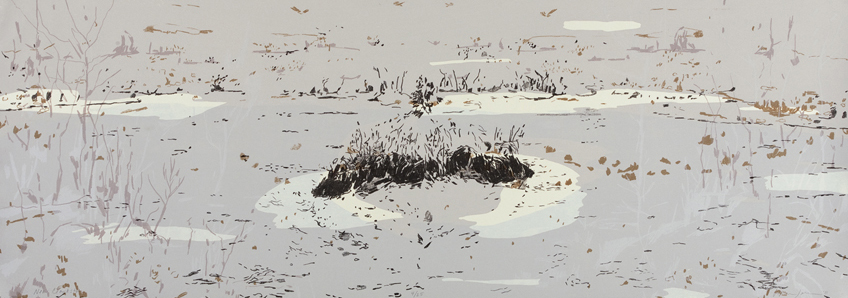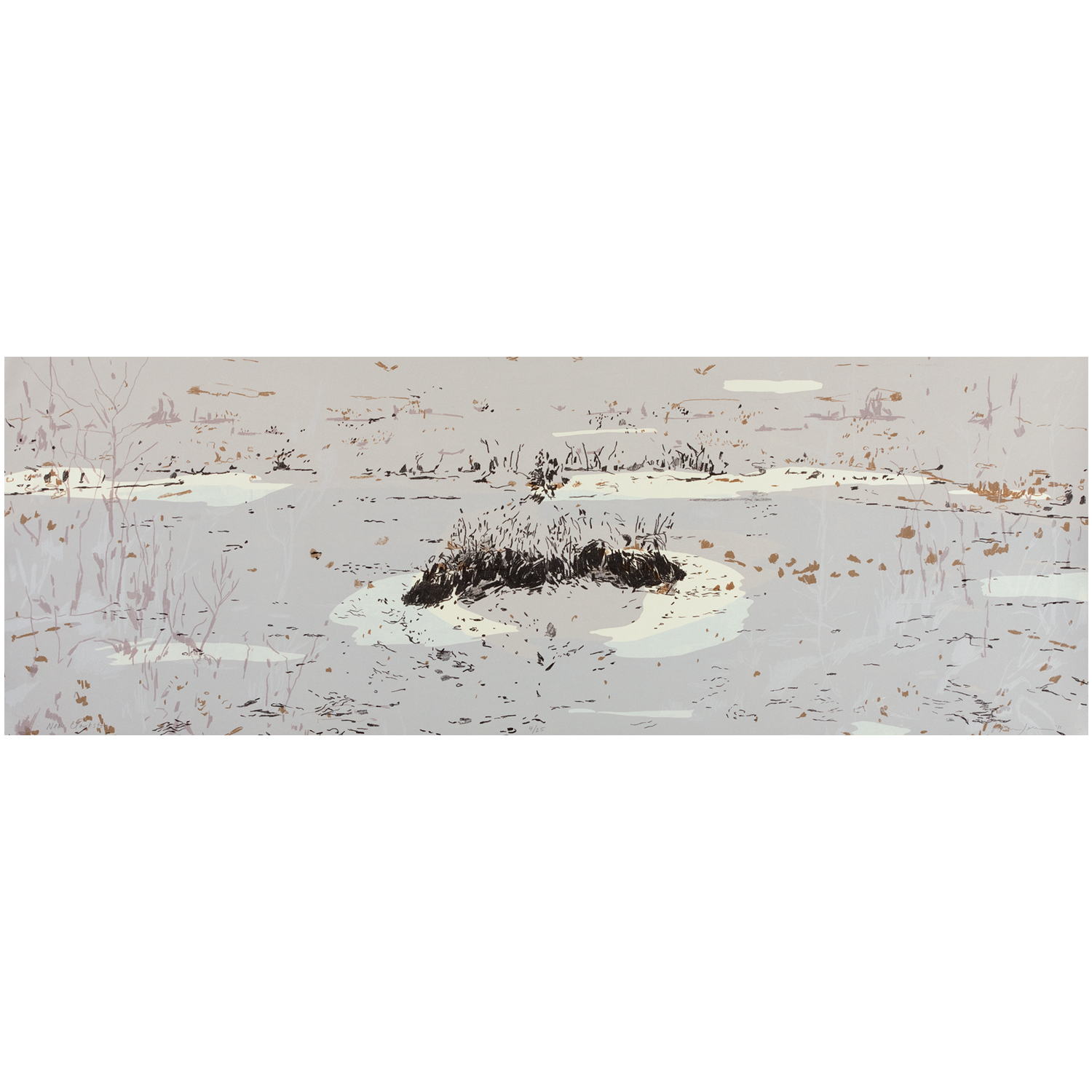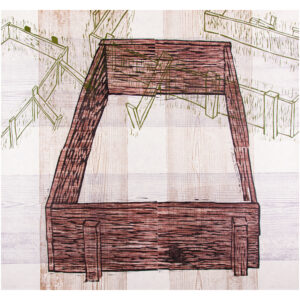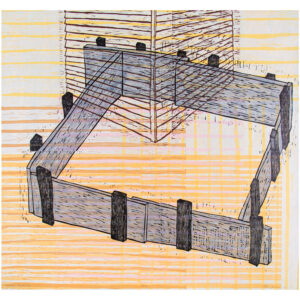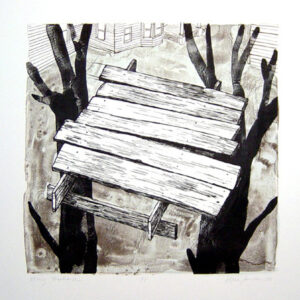Description
Resources:
Gesine Janzen: Floodplains
(Missoula Art Museum)
February 19 2016 – June 25 2016
This exhibition combines two of Bozeman based artist Gesine Janzen’s bodies of work that use river imagery to explore the passing of time and the elusive qualities of memory.
Janzen employs multiple print processes such as woodcut, monotype, lithography, and intaglio to layer multiple colors, forms, and veils of ink. These layers reflect the physical qualities of flowing water and mimic the act of recollection.
Janzen states, “I make images about the landscapes that have shaped my life. The indirectness of the printed image interests me because it is something removed from the initial thoughts, drawings, and actions of the artist. I work with this indirect process to build surfaces and create a quality of uncertainty. This is a creative process that includes reflection, inexactness, the depiction of an ephemeral space, and the passing of time. I look for something more than what is in front of me. I make pictures that employ the process of searching and discovery to express thoughts, sensations, and specific qualities surrounding a place.”
Janzen began to use rivers metaphorically in her work when she made the decision to trace her ancestors from central Kansas back to the Vistula River Delta in Poland. They had lived there for centuries, but left due to political pressure. Janzen says, “My artistic interest in rivers began with a 2009 trip to Poland to draw the Vistula River, which was home to my ancestors for three hundred years. They farmed the floodplain of this river and thrived along its banks, until they were forced to leave. My family’s total absence in that place where they had lived for so long struck me deeply, and what became central to my work was a strong sense of the landscape, not the people, as the only permanent entity over time.”
Janzen continued to create prints of Montana rivers, connecting her home near the headwaters of the Missouri in Bozeman to her family home in Kansas. Janzen states, “Seeking a connection with the landscape of Montana, I began looking at the Missouri… the river continues toward the Midwest and winds its way toward my childhood home in Kansas. Having focused on the Kansas landscape in my artwork for many years, the river became a physical connection between my present and my past life.”
In 2011, Janzen expanded the series by traveling to places impacted by the high water as the Missouri flooded, cities such as Kansas City, Omaha, and Pierre. In the backwaters and eddies, Janzen discovered debris washed downstream from the wreck of flood waters, and noted how “the absence of people…emphasizes the ephemeral quality of life along the river, which continues its eternal stream unaware of the human activity around it.”
This exhibition unites Janzen’s bodies of work that depict rivers. Janzen has created a powerful meditation on connection and loss, places of origin and later descendants, sensations that are familiar and foreign, and that which is cultivated versus that which is uncontained.
Janzen is Associate Professor of Art and Head of Printmaking at Montana State University (MSU). She grew up in Lawrence, KS, and studied at Bethel College, the University of Kansas, and Studio Art Centers International in Florence, before receiving an MFA from the University of Iowa. Prior to coming to MSU, she taught at the University of Missouri and the Kansas City Art Institute.
Janzen’s work is held in numerous collections, including the Nelson-Atkins Museum of Art; the Beach Museum of Art; Artist/Printmaker/Photographer Research Collection at the Museum of Texas Tech, Lubbock; Spencer Museum of Art; and the Hallmark and Sprint collections.
The art of Gesine Janzen
(Explore Big Sky)
By Sarah Gianelli EBS Associate Editor
BOZEMAN – There’s an otherworldly quality to Bozeman artist Gesine Janzen’s work, a sense of peering into the past through the soft haze of time, especially the recent pieces that diverge from her primary medium of traditional woodblock print-making. Through a process of abstraction, her exquisite prints, which are often landscape-referenced, distill a scene to its Zen-like essence of line, form and color, while retaining their wholly Western context.
But in recent years Janzen, an associate professor of art and head of printmaking at Montana State University, has expanded her creative reach to more fully explore her personal ancestral history as well as the collective, in an attempt to weave together the past and present. In the process, she’s discovering that rivers often provide the stitching.
Janzen, a native of Lawrence, Kansas, moved to Bozeman from Kansas City, Missouri, 15 years ago for a position at MSU. A 2011-2014 series of woodblock prints that track the Missouri River as it winds its way eastward from its Montana headwaters enabled her to find a connection between where she came from and where she found herself to be.
“It was a way for me to connect to Montana,” Janzen said about focusing on the river that connected the two regions. “Not really an umbilical cord, but some kind of tie to my past.”
Janzen reached even further back into her past with “Passages: I am Here; You are Here; We are Here,” an antiqued eight-page “newspaper” composed of letters written by Janzen’s Prussian ancestors in the late 1800s, and photographs of the area alongside the Vistula River, now in modern day Poland, where they lived and farmed prior to emigration. Janzen produced the work in collaboration with the Peabody Printing Museum, which printed the combination of digitally produced relief plates, painstakingly handset letter press type and photographs on the museum’s 1880s Babcock Reliance newspaper press.
“It was a way to create a dialog between me and them, past and present,” Janzen said. “Maybe I’m just a nostalgic person to begin with, but I feel that reaching back is a way for me to figure out who I am, and my place in the world. The past is something we can know something about, but the future … who knows?”
The use of newsprint highlights the ephemeral nature not only of the piece itself, but the passage of time. Part of Janzen’s attraction to printmaking is that it toys with the artist’s intrigue with time.
“There’s this idea of making an impression on a piece of paper from another surface that is kind of like capturing a moment in time,” Janzen said.
Recently, Janzen has been amassing paper reliefs of rural Montana tombstones, stiffened sheets of white calligraphy paper impressed with the stone’s lettering.
She doesn’t yet know what to make of them, so for now she’s grouped them under artwork entitled “Current Experiments,” a burgeoning collection of objects that also includes paperweights embedded with vintage artifacts.
Near her hometown in Kansas, Janzen found a barrel of individually-wrapped glass paperweight blanks cast in the 1800s, some with the decaying, brown paper still clinging to the exterior. She has begun creating little “memory capsules” out of the glass cartridges, incorporating photographs or sweet, small objects—a remnant from a rhinestone broche, a fragment of string—that strike a chord of sentimentality that is both intimate and universal.
“The experiments and the collage work have really freed me up,” Janzen said. “I decided to do whatever I wanted to do, and use objects and not just be tied to the printmaking only.”
Janzen is also one of 13 artists participating in “Upstream,” a public art exhibition exploring municipal water usage in Bozeman opening on June 16.
For the piece, Janzen met with Lain Leoniak, the water resource manager for the City of Bozeman, before composing a large canvas that combines organic forms based on a wintry photograph of nearby Sourdough Creek with information gathered during a tour of Bozeman’s water treatment plant.
“I tend to look at water as an aesthetic thing, a thing of beauty,” Janzen said. “But I don’t necessarily think of it as something that might have bacteria, and need to be filtered or cleaned so we can consume it. Art is another way to communicate, present information and invite dialogue. I thought my piece might provoke some thought about how we use water and what it is for.”
[…]

